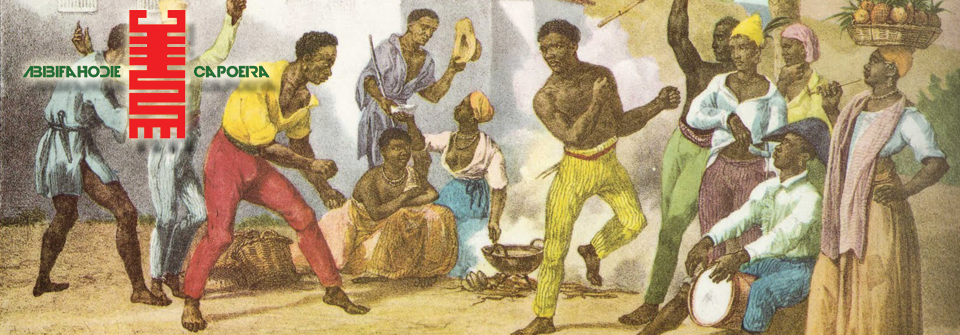Abibifahodie History
Capoeira is an Afrikan=Black combat science.
“Capoeira veio da África; Africano quem a trouxe.”
Capoeira originated as an artform of the Macupe people of Angola where it was known as N’golo due to its similarity to the movements of the Zebras when they fought. It was associated with the male rites of passage whereby a young man who was able to best other youths of his age grade was afforded the opportunity to marry without having to pay the bridewealth. According to pre-eminent scholar of Bantu culture, Dr. Kibwandende kia Bunseki Fu-Kiau the word Capoeira itself is Afrikan and comes from the Kikongo word Kipura – to flutter around like roosters in cockfights.
With the coming of the portuguese and their mandate from the pope to reduce all non-catholics to enslavement, many of the Macupe, Bakôngo, Ovimbundu and other Bantu people were enslaved where they were taken to the then portuguese colony of Brasil. During this time on the continent, during the Maafa (“Middle Passage”) and once in Brasil, the artform took shape as an instrument of liberation as Afrikans relentlessly fought off the portuguese enslavers and established some of the first free (non-slave) republics in the western hemisphere, known in Kikôngo as Kilombos (portuguese Quilombo). One of the best known Kilombos was Palmares led by its legendary leader Zumbi. Here, Afrikans were dreaded by portuguese for using razor blades stuck in between their toes and hopping from trees slashing their enemies as the fell. Much of the malícia, or trickery, associated with Capoeira was deployed in the guerrila warfare struggles waged against an often better-equipped enemy.

In the war of the triple alliance against Paraguay in 1865, Brasil offered Afrikans who would fight in the war their freedom upon returning. Due to the reliance on hand-to-hand combat in trenches, Capoeiristas such as Cezario Alvaro da Costa, Antonio Francisco de Mello and the battallion “Zuavos Bahianos” were able to distinguish themselves. This is enshrined in the Capoeira song Paraná ê.

Despite the heroism of the Capoeiristas on the battle field, capoeira began to get a bad reputation in urban centers. With the abolishment of chattel enslavement, Capoeira flourished as an urban phenomenon in Bahia, Rio de Janeiro, Pernambuco etc., up until its ban due to association with malandros (thugs) in 1890. Oftentimes, politicians would hire capoeiristas to beat up supporters of political rivals. Capoeiristas were also known to use straight razors to slash the throats or enemies and victims. This led Capoeiristas to wear red silk scarves (so that an attacker’s razor blade would not cut through) to protect their own necks. With the state repression of capoeira, many practitioners had to practice underground leading to such toques as “Cavalaria” which would alert Capoeiristas that the police were approaching. Due to repression, Capoeira became almost extinct except for in Bahia in general and Salvador da Bahia in particular. It is worth noting that some practitioners were able to survive repression in other cities and regions.
With the fall of the expansion and decline of the Ọ̀yọ́ empire and the last major wave of enslaved Afrikans coming from the so-called “Slave Coast”, modern-day Nigeria, Capoeira came to be associated with Candomble, a syncretistic spiritual system founded on Yorùbá spirituality which incorporated various aspects of the vestiges of Bantu spirituality (such as Macumba). As such, capoeristas developed a symbiotic relationship where they would go to the practitioners of Candomble for spiritual protection and in turn offer physical protection for the Candomble houses.
In the past Capoeira was practiced with 3 drums rather than the 3 berimbau (also of Afrikan origin) configuration used in Capoeira Angola today. Those drums were known as rum, rumpi, and iê due to the different pitches of sounds they produced. Iê is still the distinctive call announcing the beginning of the opening ladainha and the close of the final corrido songs sung in the capoeira roda.
As Capoeira developed, many other changes were introduced such as those introduced by Mestre Bimba to change the image of Capoeira and also to get it legalized. In a performance for the governor of the state of Bahia, Juracy Magalhães, Mestre Bimba succeeded in convincing authorities of the cultural value of Capoeira and went on to establish the first official capoeira school, Academia-escola de Cultura Regional, in 1932. This is where the Capoeira style known collectively as Regional gets its name and distinctive styles attributed to Mestre Bimba’s introduction of techniques from Batuque, another Afrikan=Black combat science. The legalization led to other schools being established, most notably Mestre Pastinha’s Centro Esportivo de Capoeira Angola, the first school of Capoeira Angola, in 1942 in Pelourinho. A third strand of Capoeira, Capoeira da Rua (Capoeira of the streets) also continued to develop and is still practiced most notably at Mercado Modelo in Bahia.
Capoeira has now spread across the world and Abibifahodie Capoeira marks a milestone in the return of Capoeira to its native land, Afrika, bringing things full-circle. In our capoeira indigenization and re-Afrikanization program, we are working on translating the songs and lessons found in portuguese into one of the primary indigenous languages of Ghana, Twi. Additionally we are incorporating songs from other Afrikan languages such as Yorùbá and Kikongo.
Abibifahodie upholds the tradition of Capoeira as an instrument of Afrikan Liberation and is open to all Afrikan people of the continent and the diaspora. If you live in Ghana or plan on being in Ghana and are interested in training in Capoeira, contact us today!
Dr. Ọbádélé Kwame “Africano” Kambon
+233249195150
